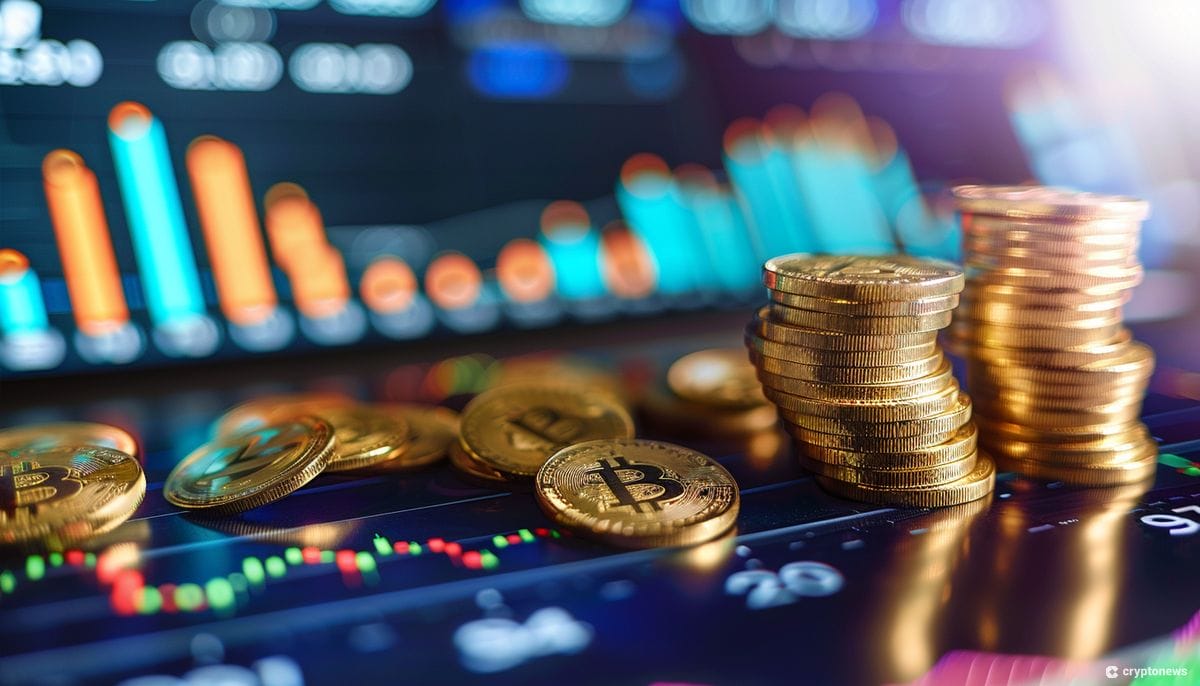Billionaire Arthur Hayes Says Bitcoin Price Action Before and After Halving “Could be Negative”
 Billionaire Arthur Hayes has expressed a cautious view regarding the upcoming Bitcoin halving and the effects it will have on the price of the asset.
Billionaire Arthur Hayes has expressed a cautious view regarding the upcoming Bitcoin halving and the effects it will have on the price of the asset.
While many experts anticipate a significant rally for Bitcoin following the halving event, Hayes believes that the price action before and after the event could actually be negative.
In a blog post published on April 8, Hayes pointed out that the prevailing narrative surrounding the halving is that it will have a positive impact on crypto prices.
However, he cautioned that when the market consensus leans heavily towards a particular outcome, the opposite often occurs.
Based on this observation, Hayes believes that Bitcoin and crypto prices, in general, may experience a slump around the time of the halving.
US Dollar Liquidity to Impact Crypto Markets
Another factor contributing to Hayes’ apprehension is the tightness of United States dollar liquidity around the estimated halving date.
He believes that this scarcity of liquidity will fuel a sell-off of crypto assets.
As a result, Hayes has decided to abstain from trading until May, referring to the period between April 15 (the tax payment deadline) and May 1, when the Federal Reserve is expected to discuss a potential reduction in its Quantitative Tightening program.
Hayes explained that the anticipated reduction in the pace of QT is favorable for dollar liquidity as the decline in the Fed’s balance sheet slows.
He sees May 1 as a turning point, marking the end of a precarious period for risky assets and a return of liquidity as Janet Yellen and the Fed take measures to boost asset prices.
Arthur Hayes predicts that Bitcoin prices will plummet before and after the halving, US dollar liquidity will be tighter than usual at that time, which will add impetus to the crazy selling of crypto assets. However, after May 1, the QT rhythm will slow down and return to the… pic.twitter.com/nOT6D4I7Y8
— Wu Blockchain (@WuBlockchain) April 9, 2024
While Hayes does not plan to short the market outright, he has closed profitable positions in various cryptocurrencies and intends to remain in a no-trade zone until May 1.
“From now until May 1st, I will be in a no-trade zone. I hope to return in May with dry powder ready to deploy to position myself for the bull market to begin in earnest.”
Other Crypto Veterans Remain Optimistic
Despite billionaire Arthur Hayes’ cautions view, other industry executives, such as Ripple CEO Brad Garlinghouse, remain optimistic.
Garlinghouse predicts that the total market value of cryptocurrencies will double this year, largely driven by spot ETFs and Bitcoin halving.
He believes that the introduction of real institutional money through ETFs is a significant factor contributing to this positive outlook.
“I’m very optimistic. I think the macro trends, the big picture things like the ETFs, they’re driving for the first time real institutional money,” he told CNBC on April 7.
Likewise, Matteo Greco, research analyst at digital asset firm Fineqia International, expects Bitcoin to reach $75,000 by the halving event.
“Historically, BTC halving events have marked significant points followed by 9-18 months of uptrend, culminating in cycle peaks,” he wrote in a recent note.
On another positive note, investors poured a total of $646 million into crypto products, pushing the year-to-date inflows to an unprecedented $13.8 billion and surpassing the previous year’s total of $10.6 billion.
You might also like
Veteran Trader Peter Brandt Raises Bitcoin Price Target to $200,000 Following Bullish Breakout
Metaplanet’s Stock Surges by 90% in Two Days After Adding $6.56M in Bitcoin to Balance Sheet
 Web3 infrastructure provider Metaplanet (3350) has seen a surge in its Tokyo-listed stock by nearly 90% within just two days after adding $6.56 million worth of Bitcoin (BTC) to its balance sheet.
Web3 infrastructure provider Metaplanet (3350) has seen a surge in its Tokyo-listed stock by nearly 90% within just two days after adding $6.56 million worth of Bitcoin (BTC) to its balance sheet.
According to data from Google Finance, the company’s shares are currently trading at 36 yens, up by 89% over the day.
The surge is largely attributed to Metaplanet’s move to add Bitcoin to its balance sheet, which came in collaboration with Sora Ventures, Mark Yusko from Morgan Creek Capital, and other prominent partners.
Metaplanet, previously known as Red Planet and operating as a budget hotel operator, has transitioned into a Web3 software developer.
Metaplanet Buys Bitcoin to Hedge Against Inflation
Earlier this week, Metaplanet revealed its decision to incorporate Bitcoin into its treasury assets due to several factors.
Firstly, it aims to minimize its exposure to the Japanese yen, which has been significantly impacted by Japan’s low-interest-rate environment.
Over the years, the yen has lost its position as a major global currency.
In a shareholder update, Metaplanet expressed concern about the yen’s vulnerability and highlighted Bitcoin’s potential as a hedge against inflation, a tool for macroeconomic resilience, and a source of long-term capital appreciation.
The company’s strategy closely resembles that of MicroStrategy, a software developer based in Tysons Corner, Virginia.
MicroStrategy made headlines in 2020 when it announced its intention to accumulate bitcoin as part of its corporate treasury holdings.
Since then, MicroStrategy’s stock price has frequently mirrored the fluctuations in Bitcoin’s value, reflecting investors’ sentiment toward the cryptocurrency market.
Presently, MicroStrategy holds the largest corporate bitcoin reserves, with more than 214,000 bitcoins valued at over $15 billion, according to bitcointreasuries.net.
Jason Fang, the managing partner and co-founder of Sora Ventures, shared his perspective on the partnership with Metaplanet.
He emphasized that this collaboration offers Japanese investors an opportunity to gain exposure to cryptocurrencies through a publicly traded company, eliminating the need to hold the assets directly.
This alternative investment avenue also mitigates the high tax imposed on unrealized crypto gains, which has been a contentious issue in Japan.
Excited to announce that @sora_ventures is working with @Metaplanet_JP, a listed company on the Tokyo Stock Exchange to create Asia’s first Microstrategy. The product will enable Japanese to gain exposure to bitcoin without paying an unrealized gains tax that could go as high as… https://t.co/TvAosMDDOM
— Jason Fang ᛤ (@JasonSoraVC) April 8, 2024
Corporate Bitcoin Holders Start to Reap Rewards
A number of major corporate investors in Bitcoin, including Microstrategy, have already seen their profits skyrocket.
As per data aggregated by Saylortracker, at current market prices of around $65,000, MicroStrategy’s position now commands a total valuation exceeding $12.57 billion.
This means the company sits on tremendous unrealized profits of almost $6.5 billion on paper – reflecting a gain of almost 104% yield-to-date from an investment allocation started under Saylor back in 2020.
As of now, Bitcoin is trading at around $69,000, down by more than 3% over the past day.
The leading cryptocurrency is 5% away from its all-time high of $73,750 registered on March 14.
Solana Developers Target April 15 for Fixing Implementation Bug Causing Transaction Failures
 Solana developers have set their sights on April 15 as the implementation date for a fix to address the bug issue that recently led to a surge in transaction failures on the Solana network.
Solana developers have set their sights on April 15 as the implementation date for a fix to address the bug issue that recently led to a surge in transaction failures on the Solana network.
The network experienced significant disruption, with over 75% of non-vote transactions failing. Per the team, an “implementation bug” in Solana’s use of the QUIC protocol caused the failures.
Solana Network Faces Implementation Bugs, Not Design Flaws, Says Helius Labs CEO
solana's current issue is not a design flaw, it's an implementation bug
it is now hitting me that some folks might not understand what we've been trying to say by this for the past week
I'll simplify it (intended for non-technical people)
it is important to make this… pic.twitter.com/fNZzu9f90S
— mert | helius.dev (@0xMert_) April 8, 2024
Mert Mumtaz, CEO of Helius Labs—a firm providing back-end support to the Solana network—highlighted the difference between implementation bugs and design flaws. He assured the community that while implementation issues can be addressed more straightforwardly, design flaws would indicate more serious, foundational problems.
The surge in transaction failures on Solana peaked on April 4, with over 75% of non-vote transactions failing amidst a frenzy of memecoin activity on the network. Subsequently, the failure rate has reduced to 64.8%.
Mumtaz explained that the root of the problem lies in Solana’s implementation of “QUIC,” a data transfer protocol developed by Google, intended to keep all network nodes updated on the network’s status.
Mumtaz compared this situation to car design. He noted that all cars have basic components like tires and an engine. However, the implementation can vary significantly across different manufacturers. He suggested that Solana’s current issue resembles the need for a “tire change” rather than a complete redesign.
All cars have four tires and an engine. However, “there are many implementations of the car design,” like BMW, Mercedes, Toyota, F1, and Tesla, he explained.
Using the example of a BMW model with poor steering, Mumtaz clarified that such issues do not imply a flaw in all cars. This rather applied to that specific model. Similarly, Solana’s implementation of QUIC has deficiencies and bugs that should be addressed. However, this does not indicate a fundamental flaw in the network’s design.
In blockchain terms, Mumtaz explained that Solana needs to address this issue by “changing a tire” rather than completely redesigning the network. This distinction is crucial for understanding the nature of the problem and the proposed solution.
Further commentary came from Solana researcher Richard Patel, who indicated that another Solana implementation, Firedancer, might not exhibit the same problems.
For Agave, the tricky part lies in retrofitting external dependencies like quinn and rustls. Their devs are working on it.
This is why we've designed @jump_firedancer's custom net stack & QUIC server with these network practices in mind. Pushing hard to bring it to mainnet!
— Richard Patel (@fd_ripatel) April 7, 2024
The fix for Solana’s implementation bug is slated for April 15, pending successful testing. Mumtaz clarified that a superior solution will be implemented at a later date.
Solana Community Raises Concerns Over Network Congestion and Transaction Errors
Community concern has arisen due to Solana’s significant market capitalization of $79.9 billion, with an additional $4.6 billion locked on the network, according to DefiLlama. However, the forthcoming developer fix aims to mitigate these concerns and enhance Solana’s network stability.
Users of the Solana blockchain reported increasing issues around network congestion and transaction errors over several weeks. New projects, especially those planning token launches, decided to hold off until the Solana team resolved the technical difficulties.
Several Solana projects, including Suit Up, DuckCoin, and Surge Finance, have experienced congestion-related issues on the network, leading to delays and disrupted user experiences.
3/ The core issue relates to a QUIC implementation, and the behavior of the Agave validator client on @solana when asked to process a large number of requests. Anza engineers, with other core contributors, have been working around the clock to diagnose and remedy bottlenecks and…
— Anza (@anza_xyz) April 5, 2024
On April 5, Anza, a Solana-focused software development shop, outlined its plan to address network congestion. This will happen through its Solana validator client implementation, Agave, also attributing the root cause to issues around QUIC implementation.
Despite these issues, trading, fiat withdrawal, and deposit functionalities remain unaffected.
Furrever Token Presale Emerges as a Safe Haven for Solana (SOL) and Dogecoin (DOGE) Investors Amid Market Uncertainty
Furrever Token (FURR) Emerges with Potential for 15X ROI
Solana (SOL) and Dogecoin (DOGE) have long held the spotlight as top performers, capturing investors’ attention with their remarkable earnings. However, a newcomer, Furrever Token (FURR), is poised to challenge their dominance, offering the tantalizing potential for up to 15X returns on investment (ROI). As SOL and DOGE continue to make waves, FURR’s ambitious aim to replace them in the limelight underscores the dynamic nature of the crypto market and the constant quest for innovation and profitability.
Solana (SOL) Struggles to Recover Amidst Network Congestion
Solana (SOL), currently priced at around $180.44, has maintained stability compared to the previous day. Renowned for its efficiency, Solana stands out among major blockchain networks due to its speed and low gas fees. However, recent congestion issues have cast doubt on its narrative of seamless operation. Reports reveal a staggering 70% failure rate in transactions, a concerning trend that Solana developers are actively addressing. Despite its reputation for high throughput capabilities, Solana has encountered bottlenecks leading to widespread transaction failures, with data from April 8 indicating a significant portion of transactions not going through.
Anza, a developer collective specializing in Solana, has acknowledged the urgency of the situation and is working on solutions, linking the congestion to specific implementations of internet transport protocols and Solana’s validator client behavior. These challenges have intensified under heavy request loads, fueled by a surge in memecoin speculation and bot trading, positioning Solana’s network traffic to surpass Ethereum’s. While presenting challenges, Solana’s congestion issues offer valuable lessons for the broader blockchain community, emphasizing the importance of robust network design, continuous testing, and adaptive development to meet evolving user demands.
Dogecoin (DOGE) Caught a New Wave
Dogecoin (DOGE/USD) has surged by 12% in the past 24 hours, reaching $0.20 and attracting continued interest from crypto investors and traders. With its trading volume soaring to approximately $2.91 billion, Dogecoin’s rise to the 8th position on CoinMarketCap, with a market capitalization of $28.40 billion, highlights its growing acceptance and popularity.
Impressively, Dogecoin has witnessed a significant uptick in open positions, climbing by 9.35% to reach $1.58 billion. Major exchanges like Binance, Bybit, and BingX have contributed significantly to this increase, reflecting substantial trading activity across various platforms.
Dogecoin’s mainstream acceptance, public approval, and escalating interest from retail investors significantly influence its market dynamics. Initially emerging as a playful cryptocurrency in 2013, Dogecoin has cultivated a unique fan base and garnered visibility and popularity through celebrity endorsements.
Technical analysis reveals a pivot point at $0.18, with resistance levels at $0.20, $0.22, and $0.25. Support levels are identified at $0.17, $0.14, and $0.12, providing crucial safeguards against potential downtrends. Supported by a Relative Strength Index (RSI) of 62 and a 50-day Exponential Moving Average (EMA) at $0.18, Dogecoin’s past performance suggests potential for continued upward momentum.
In summary, as Dogecoin exhibits an upward trend above its pivot point at $0.1844, careful attention to these significant technical levels is essential amidst its current market dynamics.
Furrever Token (FURR): Tempting SOL and SHIB Investors with High ROI Opportunities
Introducing Furrever Token (FURR), a cryptocurrency project aiming to captivate investors from both the Solana (SOL) and Shiba Inu (SHIB) communities with enticing high Return on Investment (ROI) offers. FURR is not just another digital asset; it represents a whimsical fusion of blockchain technology and the universal appeal of adorable cats.
FURR’s mission transcends conventional cryptocurrency use cases, focusing on creating an enchanting experience for users amidst the often serious and technical landscape of blockchain. The project aims to foster a warm and friendly community centered around cute cat imagery, integrating cat-themed stickers, emojis, and visuals into its ecosystem to evoke shared joy and camaraderie.
With its tokenomics structured around the symbol “FURR” on the BNB-20 blockchain, Furrever Token boasts around 9 billion tokens. During the presale phase, 65% of these tokens are available, with 25% allocated for DEXs and 10% reserved for the team, locked for a year to reassure investors of the project’s longevity.
One of FURR’s standout features is its potential for up to 15X returns, a figure that undoubtedly catches the attention of SOL and SHIB investors seeking lucrative opportunities in the crypto space. The project has already raised over $690,000 and is progressing through its presale stages, aiming to raise $1 million before launching on DEX (PancakeSwap).
Furthermore, FURR accepts a variety of payment options like USDT (BEP-20), ensuring accessibility for a diverse range of investors. Security and compliance are paramount for FURR, with audits conducted on its smart contract and safety measures implemented to provide a secure and enjoyable experience for all users.
At the time of writing, Furrever Token’s current price stands at $0.00048, adding to its appeal as a potential high-return investment opportunity.
In summary, Furrever Token presents a compelling proposition for SOL and SHIB investors, offering not only the potential for substantial returns but also a delightful and community-driven crypto experience centered around the irresistible charm of cute cats.
Discover the Most Exclusive Presale Opportunity of 2024 Now:
Furrever Token Official Website | Visit Furrever Token Presale
















![[ℕ𝕖𝕧𝕖𝕣] 𝕊𝕖𝕝𝕝 𝕐𝕠𝕦𝕣 𝔹𝕚𝕥𝕔𝕠𝕚𝕟 - OM(G) , My Biggest Bag Was A Scam????](https://cdn.bulbapp.io/frontend/images/99de9393-38a8-4e51-a7ab-a2b2c28785bd/1)











![[LIVE] Engage2Earn: Doubling down on Dickson](https://cdn.bulbapp.io/frontend/images/0dea4715-4791-404e-acff-82013adb11e1/1)








